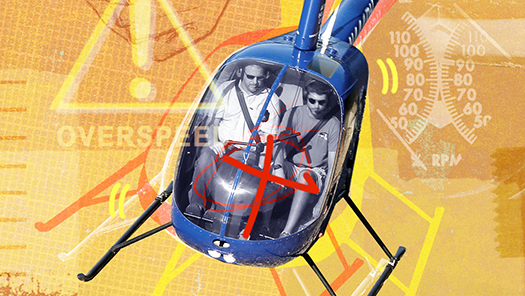Don't throttle the throttle!
Overspeed in autorotation
By Chris Greco
During a helicopter lesson, the instructor informed me we would be practicing autorotation. I was familiar with the maneuver, having had it described and demonstrated in a previous lesson with another instructor, but did not have expertise in performing it. The instructor started by explaining what an autorotation entailed and why we practice it.

An autorotation is when the helicopter’s engine fails, much like a power-off maneuver in fixed-wing aircraft. However, and here is where he was emphatic, the pilot reaction is not the same as that of a fixed-wing. He then described the collective, which is the control that determines altitude in the helicopter, and the throttle which is part of the collective “handle.” He stated that the first thing the pilot will do is put the collective in the full down position. Immediately after, the pilot should align the nose since a loss of power will mean that the yaw generated could be to the left or right depending on the reason for the power loss. The next reaction, after aligning the nose, is to ease back the cyclic. The cyclic is the control that determines pitch and roll in the helicopter. By easing the cyclic back, the pilot is allowing more air to move through the main rotors, which assists with keeping the helicopter in the air.
In addition to all this, the pilot should be determining the set-down location to judge the amount of “glide” needed to make that point. At approximately 50 feet or so above the ground, the pilot “flares” the helicopter to stop forward motion (much like the flare in a fixed wing) and gently increases the throttle (the handle on the collective) until the governor takes over and provides the normal 104-percent power to the main rotors to complete a power recovery. Sounds easy, right? Keep reading.
After the explanation, the instructor performed an autorotation flawlessly while I was shadowing on my controls. I soon seemed to be comfortable enough with the maneuver that the instructor allowed me to conduct one with him also on the controls. I happened to have a GoPro on during this lesson to review maneuvers, but in this case, it also allowed me to understand what happened when the maneuver does not go as planned.
The autorotation was executing nicely, with me placing the collective down. I aligned the nose and gently pulled back the cyclic. I kept an eye on the spot where I wanted to put the R22 and started the descent until I was the appropriate distance above the landing spot. I flared OK, but after the flare, I must have adjusted the throttle too aggressively. The helicopter suddenly yawed left and a screaming sound came from the engine. The instructor immediately took control of the situation and used his expertise to bring the aircraft under control. He set the R22 down on the taxiway and did a visual examination of all the gauges and accompanying settings to ensure it was airworthy and, since the overspeed was only a second or two, he judged that the aircraft was OK to fly so he took it around one more time and did one more autorotation, explaining to me that I had to finesse the throttle and not raise it dramatically.
Why did I try to raise the throttle instantly instead of gradually? I remembered when I was learning to fly fixed-wing and there were times when I “punched” the throttle, especially on a go-around. My flight instructor even then told me to ease the throttle into the position rather than force it, since forcing it could cause the engine to stall from forcing too much fuel into the engine.
What suggestions did my instructor make after the overspeed? First, every throttle change should be gradual when doing them manually. Second, do not wear gloves while operating the collective, which doubles as the throttle. The gloves can grip the throttle control and prevent the governor from making automated changes to the throttle. Third, and probably most important, is to relax the grip on the collective. By relaxing the grip, it allows a smooth transition of power to the main rotor blades and establishes you as flying the helicopter, not the reverse.
I review the GoPro video from that incident before I go on flights that include autorotation. In addition, when I am flying my simulator, I also practice bringing in throttle smoothly to ensure that I drill that movement into my muscle memory.
The overspeed made me realize two things. First, that I have a lot to learn even though I have time in both the R22 and fixed-wing aircraft. Second, I never take the instructor for granted. In this situation, it was like he was sitting next to me behind a glass marked “In Case of Emergency, Break Glass.” Except in this situation, it was the sudden orientation of the aircraft and the sound that broke that glass.
My current instructor told me that he will never tell me that we are doing autorotation until we are in the air. He is right on with that one. Some students, like me, are extremely anxious about maneuvers that are somewhat complex, so not knowing makes me more relaxed about the lesson and more confident about some of the more fundamental maneuvers like pick-up, quick stops, and set-downs.
A later maintenance check showed that there was no damage from the overspeed, which according to my instructor was extremely lucky but quick action prevented both a mechanical and personal disaster. 
Chris Greco is a retired Air Force officer, a private pilot, and student helicopter pilot with 200 hours in Cessnas, Pipers, R22s, and even 30 minutes a T–37. He teaches ground school for student pilots at a local community college in North Carolina.


